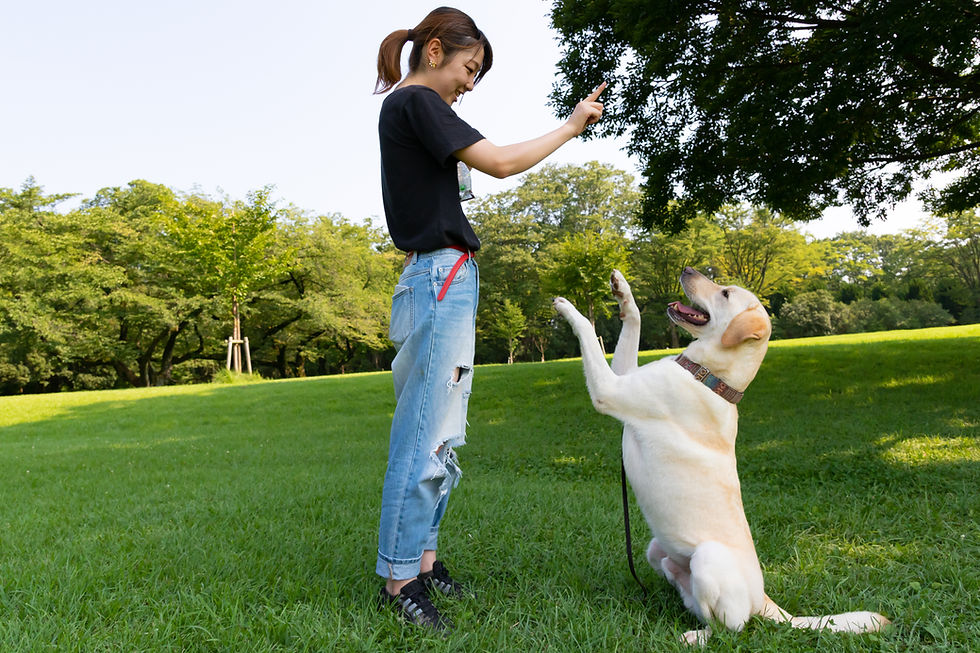What are the negatives of clicker training dogs?
- Subhodip Unitel
- Sep 16, 2024
- 3 min read
Clicker training is a popular and widely used method for teaching dogs new behaviours. It involves using a small device that makes a distinctive "click" sound to mark the desired behaviour, followed by a reward. While this technique has many benefits, it's important to understand that it may not be suitable for every dog or situation. In this blog, we’ll explore some of the potential drawbacks of clicker training, and why it might not always be the best choice.

1. Dependency on the Clicker
One major drawback of clicker training is that it can create a dependency on the clicker itself. Dogs may start to associate the sound of the clicker with receiving a reward and might not perform the desired behaviour unless they hear the click. This dependency can become problematic if you’re in a situation where you don’t have the clicker with you. For example, in the absence of the clicker, your dog might not respond to commands as effectively, which can be frustrating.
2. Initial Training Period
Clicker training requires an initial investment of time and effort. Training your dog to associate the clicker sound with a reward involves a clear and consistent approach. If the dog trainer you choose doesn’t have experience with clicker training, this process can become lengthy and confusing for both the dog and the owner. The dog may need a considerable amount of time to grasp the concept, which might be challenging for those seeking quick results.
3. Over-reliance on Treats
While clicker training focuses on positive reinforcement, it often involves the use of treats as a reward. Over time, this can lead to an over-reliance on treats for motivation. Some dogs may become fixated on receiving treats and may not perform behaviours unless they are rewarded. This can potentially lead to issues with obesity if not managed carefully, as well as a lack of interest in training if treats are not immediately available.
4. Potential for Miscommunication
Clicker training requires precise timing and consistency. If the clicker is used at the wrong moment or inconsistently, it can confuse the dog. Miscommunication between the trainer and the dog can hinder the training process, leading to mixed signals and slower progress. Ensuring proper use of the clicker demands a certain level of skill and understanding from the dog obedience trainer, which might not always be present.
5. Not Suitable for All Dogs
Not all dogs respond well to clicker training. Some dogs may be less motivated by the clicker or the associated rewards. For example, dogs with a high prey drive or those who are more food-focused might not find the clicker as engaging. In such cases, alternative training methods might be more effective. It’s important to consult with a dog training expert to determine the best approach for your individual dog.
6. Distraction in Public Places
Using a clicker in public or busy environments can be distracting for your dog and for others. The sound of the clicker might draw unwanted attention or cause anxiety in some dogs, especially those who are sensitive to noise. This can make it challenging to conduct effective training sessions outside of a controlled environment.
7. Training Environment Constraints
Clicker training often requires a controlled environment to be most effective. This can be a limitation if you’re trying to train your dog in various settings or if you travel frequently. Ensuring consistent training conditions can be difficult, which may affect the overall effectiveness of the training.
8. Long-Term Commitment
Successful clicker training requires ongoing commitment. To maintain the behaviours learned, you need to consistently use the clicker and rewards, even as your dog masters certain commands. This long-term commitment can be demanding for some owners who may find it challenging to keep up with regular training sessions.
Conclusion
In conclusion, while clicker training offers numerous benefits for dog training, it also comes with potential drawbacks. Issues such as dependency on the clicker, initial training time, over-reliance on treats, and suitability for all dogs are important considerations. Understanding these negatives can help you decide if clicker training is the right approach for you and your dog. If you're seeking professional guidance, consulting with a dog trainer or a dog training expert can provide additional insights and alternative training methods. For top-notch dog training services that cater to various needs, consider reaching out to Pawsative Choices. Their expertise can help tailor the best training solutions for your dog’s specific requirements.



ความคิดเห็น